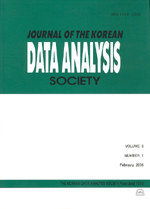은행의 재무적 상황이 주택담보대출의 변화에 미치는 영향
The Effect of Financial Condition in Korean Banks on Housing Loan Change
- 한국자료분석학회
- Journal of The Korean Data Analysis Society (JKDAS)
- Vol.18 No.1
-
2016.02353 - 363 (11 pages)
- 8

본 연구는 글로벌 금융위기 이후 국내 은행들의 대출사업 기조(stance)가 중소기업대출에서 주택담보대출로 전환되고 있다는 점에 주목하여, 해당 원인을 학문적으로 검증하고자 선행연구에서 사용된 주요 가설변수들을 중심으로 패널분석을 시행하였다. 본 연구는 2008년 1분기부터 2014년 4분기까지의 분석기간을 고려하여 4가지 형태의 패널분석방법을 적용하여, 분석결과의 신뢰성을 제고하였다. 특히, 은행 대출사업의 기조를 결정하는 영향요인으로 내부의 재무현황이 주택담보대출의 변화에 어떠한 영향을 미치는 지를 확인하였다. 주요 분석결과는 다음과 같다. 첫째, 은행의 신용위험 감수성향이 낮아질수록 주택담보대출의 증가가 이루어졌는데, 이러한 결과는 선행연구인 Nilsson, Ohman(2012), Barrutia, Espinosa(2014)의 연구결과와 일치하였다. 둘째, 은행의 대출사업 기조는 은행의 자본적정성, 건전성, 수익성 수준에 따라 유의하게 영향을 받는 것을 알 수 있었다. 즉, 충분한 자본여력과 부실여신에 대한 감내능력이 확보되었을 경우에는 주택담보대출의 증가가 이루어짐을 확인했다. 하지만, 이자수익의 창출 가능성이 높을수록 주택담보대출은 감소하는 경향을 보였다. 결론적으로 국내 은행들의 주택담보대출의 증대는 글로벌 금융위기 이후의 위험회피성향과 재무적 여건변화에 기인하는 것으로 이해된다.
This study aims at examining the theoretical backgrounds on the increase of housing loan by paying attention to the stance of loan business with switching from small and medium enterprise loan to housing loan since global financial crisis. To analyze the research topic, the methodology of panel data analysis is considered by targeting the hypothetical variables from the 1st quarter of 2008 to the 4th quarter of 2014. The main test results are as follows. First, it is found that the lower the attribute with risk-taking of banks is, the more increase housing loan is, and the evidence is line with the results of Nilsson, Ohman (2012) and Barrutia, Espinosa (2014). Second, the stance of loan business in Korean banks is affected significantly by capital adequacy, financial soundness, and profitability. Thus, the higher capital adequacy and financial soundness to bad debts are, the more rise housing loan is. However, housing loan is decreased if the expansion of profits from interest-bearing is anticipated. It is understood that the increase of housing loan is closely related with the risk avoidance and the change of financial condition within Korean banks since global financial crisis.
1. 서론
2. 이론적 배경의 검토
3. 자료 및 실증분석 모형
4. 실증분석 결과
5. 결론
References
(0)
(0)